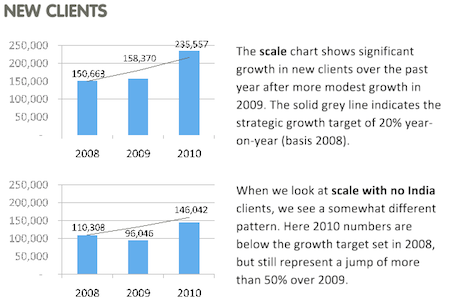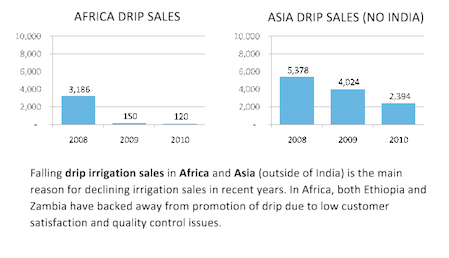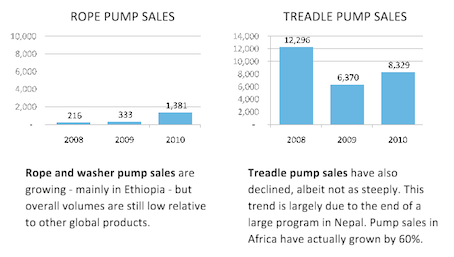About this page
GiveWell aims to find the best giving opportunities we can and recommend them to donors. We tend to put a lot of investigation into the organizations we find most promising, and de-prioritize others based on limited information. When we decide not to prioritize an organization, we try to create a brief writeup of our thoughts on that charity because we want to be as transparent as possible about our reasoning.
The following write-up should be viewed in this context: it explains why we determined that we wouldn't be prioritizing the organization in question as a potential top charity. This write-up should not be taken as a "negative rating" of the charity. Rather, it is our attempt to be as clear as possible about the process by which we came to our top recommendations.
A note on this page's publication date
The last time we examined International Development Enterprises (IDE) was in 2011. In our latest open-ended review of charities, we determined that it was unlikely to meet our criteria based on our past examination of it, so we did not revisit it.
We invite all charities that feel they meet our criteria to apply for consideration.
The content we created in 2011 appears below. This content is likely to be no longer fully accurate, both with respect to what it says about International Development Enterprises (IDE) and with respect to what it implies about our own views and positions. With that said, we do feel that the takeaways from this examination are sufficient not to prioritize re-opening our investigation of this organization at this time.
Published: December 2011
Summary
IDE works with farmers in Africa, Asia, and Central America to improve agricultural incomes. It also designs and distributes water and sanitation products through local markets.
IDE collects data that aims to answer many of the questions we are interested in, particularly: Are IDE's clients poor? Do IDE's products and services increase incomes? However, we do not believe that IDE's methods for collecting information on these questions are rigorous enough to answer these questions convincingly.
Our judgments are necessarily a function of the information we have and the limited time we can devote to any organization, but given the information we have at this time, IDE does not qualify for our highest ratings.
Our process for evaluating IDE
Our evaluation of IDE was conducted in 2011 and consisted of conversations with IDE's Monitoring and Evaluation Coordinator and Grants Coordinator, and reviewing information that IDE sent to us in response to our questions.
For details on our previous research on IDE, see our 2009 review of IDE.
What do they do?
IDE's main program is designing agricultural technology products, intervening in the supply chains for these products, and advertising the products to farmers.1 Other activities include designing and marketing clean water and sanitation products (latrines and water purifiers),2 public health communications,3 agricultural information and training for farmers, and working to increase farmer's access to finance, better prices and better inputs.4 We have not received information on how much IDE spends on each activity.
IDE works in Ethiopia, Ghana, Burkina Faso, Zambia, Zimbabwe, Mozambique,5 , Nepal, Bangladesh, Cambodia, Vietnam,6 Nicaragua, and Honduras,7 and has two "affiliate organizations" in India and Myanmar.8
Products
IDE's "product catalog" lists four types of technologies and provides details of how each product works and for what conditions each is designed:9
- Water lifting products: these products are primarily designed to bring water from below the surface to irrigate crops. Products include treadle pumps (operated manually), electric pumps, diesel pumps, rope pumps, hand piston pumps, and solar steam pumps.
- Water storage products: these products are primarily designed to (a) provide water security and (b) "provide pressurized supply to irrigation systems."
- Water application products: these products are primarily designed to use water as efficiently as possible to irrigate crops. They include drip irrigation (tubes with small holes by each plant's roots), and sprinklers.
- Groundwater access products: constructing wells, including lined and unlined wells.
In addition, IDE has introduced drinking water and sanitation products in some locations.10
Does it work?
In line with our framework for evaluating economic empowerment charities, we focused on the following questions in reviewing IDE:
- Do customers show that they value the products by purchasing them? More specifically, we asked:
- Are sales increasing over time for the same products and is IDE's village-level market penetration increasing?
- Do customers pay for the full costs of the products?
- Has IDE created profitable enterprises?
- Are products of high quality? Specifically, are customers satisfied with products and do products last over time?
- Do products primarily serve the poor?
- Do products increase customers incomes?
Note: this review does not consider the possible environmental impact of farmers switching to IDE's products.
Do customers buy the products?
IDE tracks sales made by retailers of its products through (a) warranty cards (the customer gets one copy and the retailer provides a copy to IDE), and (b) reports from IDE staff in programs where they are working more closely with farmers. IDE told us that (a) accounts for about 85-90% of sales tracked, while (b) accounts for the rest.11 We have not vetted these methodologies.
We have seen one summary-level report on sales for 2008-2010. Overall sales increased over the period, though the level of sales is highly dependent on whether sales in India (which are managed by an organization that has been spun off) are included.12
IDE also provided data on sales by country and by product, which show a large amount of variation in sales across place and product type.13
We have not requested data that would allow us to answer the question of whether sales penetration (i.e. sales within each local area, such as a village) is increasing. Increasing sales penetration would be one indication that customers find the products valuable and their neighbors take up the product as a result.
Do customers indicate that they value the products by paying near cost for them?
IDE pays for product development and advertising, and occasionally intervenes more directly in markets by providing storage for products or vouchers to customers. As a result, customers do not pay for the full cost of products, though in at least some cases, they may pay the full marginal cost (i.e. the ongoing manufacturing and distribution costs for additional units of the product).14 We have not investigated what proportion of IDE's products are sold at full marginal cost, though IDE told us selling at full marginal cost is its primary model.15
Is IDE creating profitable enterprises?
IDE created two country programs (India and Myanmar) that have since become independent organizations. In addition, programs in India, Cambodia, and Latin America have created spin off businesses that are intended to generate revenues that can cover their costs (though the businesses in Cambodia and Latin America are in early stages of development).16 We have questions about whether the spin off business in India would be profitable independent of IDE India (more in our forthcoming review of IDE India)
IDE also told us, "Most of our work is ‘facilitating’ (the working with existing businesses) rather than ‘incubating’ [new businesses]. To assess the profitability of existing businesses, we look at sales per business (to get an idea of the significance of iDE-related product/services lines to their overall business) and estimate gross profits on the basis of known or estimated margins (we don’t always know enterprises’ true margins as that tends to be closely guarded information, and rightly so, but we have a pretty good idea on the basis of known labour and materials costs)."17
Are customers satisfied with products?
IDE told us that it is now starting to systematically conduct customer satisfaction surveys, but that is does not yet have high quality survey results on the question of whether customers are satisfied with its products.18
Do products last over time?
We have not explored this question.
Are customers poor?
IDE estimates that 61% of its customers live on less than $1 per day PPP, 25% on between $1 and $2 per day PPP, and 15% on more than $2 per day.19 Incomes are estimated using retrospective reports by farmers.20 We do not know if surveyed farmers are representative of all IDE's customers, and IDE told us that it has not been able to collect high quality data in some countries.21
Do products increase users' incomes?
IDE provided data on changes in customers' incomes one year after the purchase of an IDE product, and how customers' changes in income compared to non-customers in the area.22 Incomes are estimated using retrospective reports by farmers (though IDE notes that it is revising its survey process). Farmers are asked to recall income and assets from the past two years. Incomes in the year before last (before adoption of IDE products/services) are compared to incomes in the last year (after adoption).23 IDE also shared with us an evaluation from Nepal and told us that it is conducting propensity score matching studies of changes in farmers' income, and has results from Zambia.24 We believe that these methods are unlikely to be able to isolate the impact of IDE's program. For these reasons, we do not present the findings here.
What do you get for your dollar?
We have not created a cost-effectiveness estimate for IDE.
IDE provides estimates of "cost per client" in each of the countries in which it works. It estimates that it spent $89 per client overall in 2009-2010, and that it spent $102 per client in agricultural income programs, and $27 per client in water and sanitation programs. It also estimates that it spent $372 per client in Africa and $61 per client in Asia. We have not vetted these numbers.
Room for more funds?
We have had informal conversations with IDE about how it might use additional funds,25 but have not requested details on this question.
Remaining questions
The following are questions we would seek to answer if we continued our review of IDE. At this time, we have chosen not to prioritize further work on these questions.
- Do products increase incomes? What is the impact of IDE's products on household income and standard of living?
- Are customers poor? What are IDE's customer's standards of living prior to purchasing IDE products?
- Spending by activity. How are IDE's resources divided among its different activities?
- What would IDE do with more funding? How would IDE prioritize unfunded areas if it received additional funding? How would it expect its results to change if it filled this gap?
Sources
- Brown, Joe, and Mark Sobsey. 2006. Independent appraisal of ceramic water filtration interventions in Cambodia. Chapel Hill: UNC School of Public Health.
- International Development Enterprises. Affordable safe drinking water. http://www.ideorg.org/OurTechnologies/CeramicWaterPurifier.aspx (accessed November 11, 2011). Archived by WebCite® at http://www.webcitation.org/637O1oHCM.
- International Development Enterprises. iQ overview.
- International Development Enterprises. iQ results (2011 Q1).
- International Development Enterprises. Product catalog (2011) (PDF).
- International Development Enterprises. Our locations. http://www.ideorg.org/OurLocations (accessed August 10, 2011). Archived by WebCite® at http://www.webcitation.org/60pxqOeeh.
- International Development Enterprises. Our locations: Africa. http://www.ideorg.org/OurLocations/Africa.aspx (accessed August 10, 2011). Archived by WebCite® at http://www.webcitation.org/60pxwBgpK.
- International Development Enterprises. Our locations: Asia. http://www.ideorg.org/OurLocations/Asia.aspx (accessed August 10, 2011). Archived by WebCite® at http://www.webcitation.org/60pxsnIRm.
- International Development Enterprises. Our locations: Latin America. http://www.ideorg.org/OurLocations/LatinAmerica.aspx (accessed August 10, 2011). Archived by WebCite® at http://www.webcitation.org/60pxaZVBd.
- International Development Enterprises. Zambia survey (2011).
- Hutchin, Laryl. International Development Enterprises Investor Relations Manager. Phone conversation with GiveWell, June 14, 2011.
- Taylor, Stuart. International Development Enterprises Monitoring and Evaluation Coordinator. Phone conversation with GiveWell, June 16, 2011.
- Winrock International and International Development Enterprises Nepal. SIMI project results, analysis, and future potential (2010).
- 1
Laryl Hutchin, phone conversation with GiveWell, June 14, 2011.
Stuart Taylor, phone conversation with GiveWell, June 16, 2011. - 2
Laryl Hutchin, phone conversation with GiveWell, June 14, 2011.
- 3
"IDE has also applied our expertise in rural marketing to public health education campaigns. In Vietnam, we alerted 1.8 million children and parents to the importance of hygiene in the prevention of trachoma, a blinding eye disease. In Bangladesh, we have reached some 3.4 million people with information about arsenic contamination in well water." International Development Enterprises, "Rural Marketing."
- 4
Laryl Hutchin, phone conversation with GiveWell, June 14, 2011.
- 5
International Development Enterprises, "Our Locations: Africa."
- 6
International Development Enterprises, "Our Locations: Asia."
- 7
International Development Enterprises, "Our Locations: Latin Ameria."
- 8
International Development Enterprises, "Our Locations."
- 9
International Development Enterprises, "Product Catalog (2011)."
- 10
" In Cambodia, where a new water and sanitation product (the easy latrine) has really taken off …" Stuart Taylor, conversation with GiveWell, June 17, 2011.
" To combat this probem, IDE introduced and scaled up manufacture of the "Rabbit" brand Ceramic Water Purifier (CWP), a low-cost household filter originally designed in Central America and popularized by Ron Rivera of Potters for Peace… In 2009, IDE spun off the ceramic filter project to create Hydrologic, a commercially-driven social enterprise that aims to become the premier distributor of effective and affordable safe water and household sanitation products throughout Southeast Asia." International Development Enterprises, "Affordable Safe Drinking Water." - 11
Stuart Taylor, phone conversation with GiveWell, June 16, 2011.
- 12
From International Development Enterprises, "iQ Results (2011 Q1)," Pg 1:

- 13
From International Development Enterprises, "iQ Results (2011 Q1)," Pg 1:


- 14
- GiveWell: Are all products subsidized? What is the size of the subsidy?
IDE: It's an indirect subsidy. By and large, IDE doesn't pay manufacturers or distributers. In one project, a funder did pay for vouchers as an early adopter discount, but we've moved away from that. There are cases where IDE is intervening more directly in the supply chain. In Zambia IDE warehouses the product: purchases the product, stores it, and dealers pick it up. IDE doesn't charge a margin to warehouse the products. This keeps the cost artificially low. There aren't direct subsidies in the Asian programs, but we do this in Africa where population density is low. Most of the subsidy is in warehousing and distribution." Stuart Taylor, phone conversation with GiveWell, June 16, 2011.
- GiveWell: Are all products subsidized? What is the size of the subsidy?
- 15
Stuart Taylor, email to GiveWell, November 10, 2011.
- 16
Stuart Taylor, email to GiveWell, November 10, 2011.
- 17
Stuart Taylor, email to GiveWell, November 10, 2011.
- 18
Stuart Taylor, phone conversation with GiveWell, June 16, 2011.
- 19
International Development Enterprises, "iQ Results (2011 Q1)," Pg 1.
- 20
"Based on reported crop, livestock and off-farm earning, we estimare total household income and crop profit." International Development Enterprises, "iQ Results (2011 Q1)," Pg 2.
- 21
Stuart Taylor, phone conversation with GiveWell, June 16, 2011.
- 22
"In order to track changes in client income, IDE conducts annual surveys that measure farmers' production and marketing. We collect information on baseline and one-year income (12 months after the adoption of an IDE technology or practice). We also follow smaller cohorts over the first 3 years (often there are significant gains between years 1 and 2). In order to estimate the additional income due to IDE's offerings, we compare farmers each year with a sample of control farmers - people from the same communities who did not adopt an IDE technology or practice." International Development Enterprises, "iQ Results (2011 Q1)," Pg 2.
- 23
- "Based on reported crop, livestock and off-farm earning, we estimare total household income and crop profit." International Development Enterprises, "iQ Results (2011 Q1)," Pg 2.
- IDE shared it's survey form from Zambia with us and informed us that forms in other countries are generally similar: "Please find attached a copy of questionnaire used in Zambia in March. This is fairly indicative of the instruments used to-date, although we are currently going through a revision as we evaluate the performance of the survey process over the past three years and gear up for a more standardized approach across all programs." Stuart Taylor, email to GiveWell, August 18, 2011.
- The form asks for data from both 2009 and 2010 and asks "I know it is hard to have to recall all the way back to 2009. How accurate do you feel your responses are?" International Development Enterprises, "Zambia Survey (2011)."
- 24
"We are conducting larger and more rigorous surveys with propensity scoring matching. We have initial results from Zambia for 1000 farmers. We match at a household level. We look at adopters and non-adopters, look for what predicts adoption and estimate likelihood of adoption. Match households with same likelihood of adoption." Stuart Taylor, phone conversation with GiveWell, June 16, 2011.
- 25
Laryl Hutchin, phone conversation with GiveWell, June 14, 2011.
Stuart Taylor, phone conversation with GiveWell, June 16, 2011.
